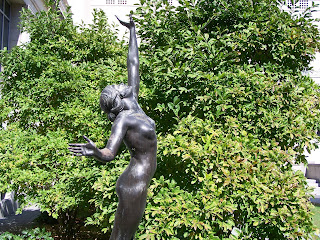
One of the missing legends of archaeology is that of the Mauktika Niila, Pearl that is Black, an indestructible statue carved from material unknown with a technique equally mysterious, and an origin lost to recorded history. The statue is so named for a chain of pearls adorning the neck in the inexplicable unity of sculpture. The pearls shine like black suns against the whiteness of the stone body, though there is no clue as to how these two opposing hues could originate in one instance of any natural substance. The hair, too, is black and the eyes retain a vivid color no one can define, as if a living woman were photographed in stone. She may have decorated the Garden of Eden, or earlier gardens beyond the grasp of memory. We gave her a Sanskrit name because it would be profane to describe her with words familiar to modern times. Only primal syllables were worthy of her conception. Many times she lay buried in the rubble of destructive wars, herself unmarred, only to be uncovered again by new civilizations sifting the ashes of earlier eras. She survived earthquakes, fires and the subtle erosions of time. In this manner she forged a path through history, appearing, then vanishing in the daze of some cataclysmic event, as her undisclosed destiny designed.
We deduced all this by looking in her eyes. In fact, there is no known mention of the Mauktika Niila in oral or written communication. No poems of passion. No paintings on temple walls. No evidence of her substance, except for the Mauktika Niila herself. Ancient Greece knew her, banning her from its mythology out of fear. Of this we were certain. We concluded the same of the ancient pharaohs, and of conjectured civilizations even before the pharaohs' time. There was reason for this. To gaze on the statue in solitude is to press one's face through the fragile film separating reality from the supernatural. The pale, white stone floods with the warm tones of flesh, as if blood had suddenly condensed in her stone veins. Her breasts reflect the scarcely perceptible motion of living lungs beneath and her eyes turn to the gazer to subsume his reason into her biology. The gazer is found later, if found at all, wandering, no memory, his identity irretrievably lost. And the Mauktika Niila, undocumented archetype of that which cannot be understood, submerges again into the unobserved chaos of time.
But I am not afraid. We know now, if two or more souls are present, the statue presents itself only as an artistic wonder. It is safe to stare, to study the form, to explore the surface with the touch of one's fingers. To assure that the unspeakable would not occur to us, we approached her over the past few weeks, my colleague and I, in tandem presence. Many fascinating clues emerged, written meticulously in our journals, clues scratching dust from the window of divinity. Our record of her would be the first the continuity of mankind had produced. We studied the pearls under magnification, excited about a nuance we detected as the spotlight shone upon her. Then, without warning, my colleague slumped to the floor, seized by a sudden asphyxiation. It is sometimes natural to die. I am sure it was natural, the death that descended upon him. What else could this have been? I stand alone at her side, appraising her eyes, unable to relax my gaze, unable to attend to his rigid form already seconds beyond the threshold of rescue. Her form glows into life, her inanimacy dissolving like a moon flaring into a sun. I cannot turn away. I dictate these words to my hands to write, but my hands do not respond. I see them hanging limp at my side, see them through her eyes. I perceive my facial features surrender to an eternity blacker than the blackest pearl. As my colleague and I had counted the pearls, a subsequent inventory, however many generations later, will show their number increased by one.
Story #427
Anyone wishing to contribute their own story inspiration to the photo, please feel welcome!












